Jewish History and Historical Fiction Books for Children (Page 3) |
If you wish to purchase any of these books, click on either the title or the book cover to be directed to Amazon.com. As a warning, I have put up pictures of the book covers to give you somewhat an idea of the style of each book (I know, I know. "Don't judge a book by its cover") so the pages may load slowly, depending on the speed of your internet connection.
If this page came up without frames, Click here to see the complete website
For history books for older readers, go to the History Books for Middle School and YA Readers Page
For historical fiction books for older readers, go to the Historical Fiction Books for Middle School and YA Readers Page
Other Pages of Interest:
Children's Jewish History and Historical Fiction Books
(Page 1) |
(Page 2) |
(Page 3) |
(Page 4) |
Easy Reader and Picture Books:
Jewish Children's Books (General) |
Jewish Board Books |
Biblical Stories for Children |
Jewish Holiday Books |
Jewish Family Cookbooks |
Folktales and Talmudic Stories for Children |
Jewish Life Books (Mitzvot, Keeping Kosher, etc.) |
Jewish Life Cycle Books |
Family Haggadahs |
Children's Prayerbooks |
Introductory Hebrew Books |
Jewish History and Historical Fiction Picture Books |
Israel Books
Middle School and YA Books:
Bar Mitzvah Books |
Jewish Fiction |
Historical Fiction |
Torah Study |
Prayer and Jewish Life Books |
Jewish Holidays |
Jewish Biographies |
Jewish History Books |
Holocaust Books for Teens |
Israel Books
Jewish Children's Books |
Bar Mitzvah Books |
Jewish Parenting Books |
Jewish Music for Children |
Jewish Children's Videos |
Jewish Jewelry
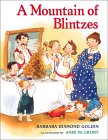
A Mountain of Blintzes
By Barbara Diamond Goldin
Each spring Sarah, Max, and their children look forward to celebrat-ing
Shavuot with a mountain of delicious blintzes. But this year Sarah and
Max are worried. Their pockets are empty, and with no extra money to spare,
how can they afford to make a special treat like blintzes? Join Barbara
Diamond Goldin's funny, big-hearted family in preparation for Shavuot,
the Jewish holiday celebrating the day Moses received the Ten Commandments,
and discover-as they do in a way that's sure to spark giggles-the true
meaning of cooperation.
Description from Publisher
A delightful and satisfying tale celebrating the Jewish holiday of Shavuot.
According to tradition, Jews are supposed to eat dairy foods to commemorate
the day that Moses received the Torah on Mount Sinai, and hardworking Sarah
would love to make a mountain of cheese blintzes for her husband and five
children. However, with such a large family to feed, she cannot afford to
buy all the ingredients, until she comes up with an ingenious plan. For the
two weeks preceding the holiday, she and her husband will each work a little
extra, every day putting their additional earnings into a special coin box.
With both of them saving a little each day, surely they will have enough by
Shavuot. Of course, neither Sarah nor Max part with the extra coins, each
rationalizing that the other will do so. Ultimately, it is their resourceful
children who provide the ingredients for the celebratory mountain of blintzes.
Loosely based on a traditional Chelm tale, this story is set in the Catskills
in the late 1920s, providing a charming small-town locale for the sunny
watercolor illustrations. Utilizing a bright, friendly palette and endearing
pink-cheeked characters, the illustrations tell an amusing story within a
story, as the children find their own ways to contribute to the Shavuot table.
Background notes and recipe are included.
Description from School Library Journal

Rose Blanche
In wartime Germany, Rose Blanche witnesses the mistreatment of a little boy, and follows the
truck that takes him to a camp. Secretly, Rose Blanche brings him and other children food.
"An excellent book to use not only to teach about the Holocaust, but also about living a life
of ethics, compassion, and honesty."--School Library Journal
Description from Publisher
During World War II, a young German schoolgirl, Rose Blanche, follows the soldiers when
they arrest a boy and discovers a concentration camp in the woods. Thereafter , she takes
food to the prisoners until the town is liberated. Ironically, when she travels to the camp on
that day she is shot by the soldiers. The oppression of Fascism is shown through the powerful
and realistic paintings. In Innocenti's large, meticulously detailed paintings, Rose Blanche is
the only brightly colored individual, and her small figure is set against the drab colors of
overwhelming buildings and masses of soldiers and townspeople. No skyline is shown until
a radiant spring bursts forth at the site of her death after the liberation. Although the story is
simply told, it will require interpretation as details such as the concentration camp are not
named nor explained, and the death of Rose Blanche is implied but not stated. This is a
difficult book to classify, as the text is easy enough for a young child to read alone, and it
has the appearance of a picture bookbut the content of the text and illustrations is full of
emotional impact and subtlety.
Description from School Library Journal

The Castle on Hester Street
By Linda Heller
Delightful and funny! Grandpa tells the story of his trip from Russia to
New York pulled by a flying goat, of buttons the size of sleds, and of
a castle on Hester Street. Grandmother tells the way it really was.
Description from Publisher
A clever way to introduce the immigrant experience.
A grandfather tells his grandaughter tall tales about each stage in his
immigration to the U.S. and his early life in New York. Then the
grandmother deflates each tale and explains how things really were
back then. I find this two-step process to be a clever way to teach
children about the experience which their grandparents went through,
first hooking them with a silly story, and then hitting them with the
facts. The book is especially useful for reading aloud to children
whose grandparents can no longer tell the story themselves, or for
inspiring children to ask their grandparents about their experience.
From Amazon.com customer review

Shpeter: A Latecomer in Early History

Shpeter: From the Depths to the Heights
A grandfather recounts to his eager grandchildren the hair-raising adventures of
Shpeter, a Jewish boy in Biblical times with the all-too-common habit of putting
things off until "later." Shpeter's troublesome trait and his natural curiosity
spark the amusing tales collected in these two volumes, creatively adapted from
the Bible and Midrash for readers ages 6 and up.
Shpeter:
A Latecomer in Early History, Book One introduces Shpeter: the last
Jew in Egypt, the only Jew to swim across the Red Sea, the only one to sleep
through the giving of the Torah, and the little boy who had a special meeting
with Moshe Rabbeinu.
Shpeter:
From the Depths to the Heights, Book Two relates further escapades of
Shpeter: expert rock climber, the thirteenth spy to enter Eretz Yisrael, the
plaything of nasty giants, and the inventor of the hang
Description from Publisher
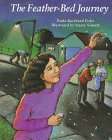
The Feather-Bed Journey
By Paula Kurzband Feder
When Rachel and Lewis accidentally rip open Grandma's old feather
pillow, they are puzzled by her great concern. She explains that the small
pillow was once a large feather bed that belonged to her family in
Poland. A child during World War II, Grandma and many other children
kept warm with the feather bed in the crowded ghetto where they lived. The
bed remained when Grandma left--first to hide with a Polish family, later
to survive with others in the woods. At the end of the war, she was reunited
with her mother and emigrated to the U.S. Eventually the bed (now reduced
to pillow-size, the result of a fire) made its way back to its original owners,
and Grandma has treasured it ever since.
Feder's simple text meshes nicely with Schuett's acrylic and pastel artwork,
providing young children with an emotional and thoughtful glimpse at a tragic
chapter of history. Useful for introducing the Holocaust to primary listeners,
this may also spur children to discover their own family stories.
Description from Booklist
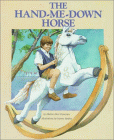
The Hand-Me-Down Horse
In her first children's book, Pomeranc carefully tailors to her young audience
a post-Holocaust tale that ends happily for a Jewish boy and his family.
Launching the story after the war has ended, the author avoids the horrifying
details of the Holocaust, instead noting more generally that after the Solomons
left their home in Germany they had "fled from village to village, living in
forests and on farms, always seeking safety, food and shelter but finding danger
and destruction instead." Now they are living in a one-room apartment in an
unnamed location, waiting for their chance to board a "Liberty ship" that will
take them to New York. A wooden rocking horse left behind by an American-bound
child helps David pass the time and gives him hope that his turn to begin a new
life will eventually arrive. Yardley's (The Bracelet) spare, pastel-hued
watercolor and pen-and-ink art favors sunny depictions of David and his
surroundings, reinforcing the reassuring, upbeat messages of the narrative.
Description from Publishers Weekly
Awards:
- 1997 CBC/NCSS Notable Trade Book
- 1996 Notable Book for Children (Smithsonian Magazine)
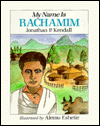
My Name Is Rachamim
Rachamim and his family, Jews suffering from discrimination in Ethiopia,
are forced to flee the country and finally make it to a new home in Israel.
Description from Publisher

Grandmother and the Runaway Shadow
Based on the author's and the illustrator's own family immigration
stories, this picture book tells of a young Jewish woman coming to
America to escape persecution in Eastern Europe around the turn of
the century. "When my grandmother came to this country, a runaway
shadow came with her." Her shadow gives her courage, makes her
laugh, and shares her memories as she runs from her village,
crosses the ocean, and finds a home, work, and friends in America.
The idea of a secret companion will appeal to children, but the
repeated mention of the shadow on every single page is overdone,
especially since the immigrant story is drama enough.
The oil paintings, in shades of brown, with rhythmic, sweeping lines,
capture the vitality of the period, the flowing crowds in the
tenement streets, the workers in the garment factory, and the
brave young woman who finds in herself--in her own shadow--the
strength for her journey. There's a story like this in nearly
every family.
Description from Booklist

A Knock at the Door
Although they don't know anything about her, a farmer and his
wife take in a secretive, starving young woman and allow her
to hide on their isolated farm when the Nazis come looking for
her. Based on the experiences of the author's grandmother.
Description from Publisher
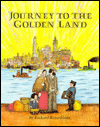
Journey to the Golden Land
By Richard Rosenblum
Many years ago Benjamin and his family set out on a long journey. They were eager to leave
the hard life of their Russian homeland for the comfort and wealth of America. America was
far away. And getting there would involve many difficulties. There was the fear of getting
caught, an over-crowded train, a packed, rocky ship, and finally, the terrors of Ellis
Island.
Description from Publisher
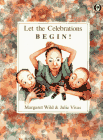
Let the Celebrations Begin!
Miriam is 12 years old. She lives in hut 18, bed 22, in the Belsen
concentration camp. She has almost nothing: no food and no toys.
As World War II nears its end, Miriam and the women in the
camp plan a very special party for the children. They are making
toys - incredible toys out of scraps and rags. For when the soldiers
come and the war is over, they will celebrate their freedom.and
the power of the human spirit to survive.
Description from Publisher
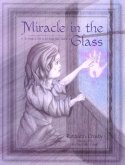
Miracle in the Glass
By Ruthann Crosby
Miracle in the Glass is the captivating story of a mother and her daughter and their devotion to each other. It captures the heart and soul of the Holocaust; those who did not survive and those who dared to live on. It shows that life is not to be taken for granted. Miracle in the Glass also shows that children are our hope for the future. To save a child is to save the world.
Mrs. Crosby, in her fictional story of a mother's sacrifice for her young daughter, brings to light a unique message hidden in the modern world's most horrific crime against humanity. Often stories of the Holocaust are fraught with unspeakable despair and human tragedy. However, Mrs. Crosby, through her tender story, illuminates the effect of the Holocaust that forever vanquished the Nazi's hope of destroying the Jewish nation. The Holocaust begot a generation of Jews with a stronger and deeper faith in G-d than ever before.
Survivors of the Holocaust were touched by the power of the Almighty who granted strength and courage in times of despair. As illustrated by Sasha's embrace of her mother's faith, these survivors grew a renewed commitment to Judaism and the strong desire to kindle this faith in future generations. Instead of destroying the Jewish faith, the Holocaust served to make us stronger and to define the eternal nature of Judaism. This growing cycle of faith is our resounding answer to the atrocities which occurred during World War II.
Description from Publisher
Page 1 |
Page 2 |
Page 3 |
Page 4
Still can't find what you're looking for? Search Amazon.com's database directly.
©1999-2009
(NOTE: The following links have NOT been placed on the site by the website owners. We have no control over which ads are selected and are not responsible for their religious content.)
If this page came up without frames, Click here to see the complete website
For history books for older readers, go to the History Books for Middle School and YA Readers Page
For historical fiction books for older readers, go to the Historical Fiction Books for Middle School and YA Readers Page
Other Pages of Interest:
Children's Jewish History and Historical Fiction Books
(Page 1) |
(Page 2) |
(Page 3) |
(Page 4) |
Easy Reader and Picture Books:
Jewish Children's Books (General) |
Jewish Board Books |
Biblical Stories for Children |
Jewish Holiday Books |
Jewish Family Cookbooks |
Folktales and Talmudic Stories for Children |
Jewish Life Books (Mitzvot, Keeping Kosher, etc.) |
Jewish Life Cycle Books |
Family Haggadahs |
Children's Prayerbooks |
Introductory Hebrew Books |
Jewish History and Historical Fiction Picture Books |
Israel Books
Middle School and YA Books:
Bar Mitzvah Books |
Jewish Fiction |
Historical Fiction |
Torah Study |
Prayer and Jewish Life Books |
Jewish Holidays |
Jewish Biographies |
Jewish History Books |
Holocaust Books for Teens |
Israel Books
Jewish Children's Books |
Bar Mitzvah Books |
Jewish Parenting Books |
Jewish Music for Children |
Jewish Children's Videos |
Jewish Jewelry
Other Pages of Interest:
Children's Jewish History and Historical Fiction Books
(Page 1) |
(Page 2) |
(Page 3) |
(Page 4) |
Easy Reader and Picture Books:
Jewish Children's Books (General) |
Jewish Board Books |
Biblical Stories for Children |
Jewish Holiday Books |
Jewish Family Cookbooks |
Folktales and Talmudic Stories for Children |
Jewish Life Books (Mitzvot, Keeping Kosher, etc.) |
Jewish Life Cycle Books |
Family Haggadahs |
Children's Prayerbooks |
Introductory Hebrew Books |
Jewish History and Historical Fiction Picture Books |
Israel Books
Middle School and YA Books:
Bar Mitzvah Books |
Jewish Fiction |
Historical Fiction |
Torah Study |
Prayer and Jewish Life Books |
Jewish Holidays |
Jewish Biographies |
Jewish History Books |
Holocaust Books for Teens |
Israel Books
Jewish Children's Books |
Bar Mitzvah Books |
Jewish Parenting Books |
Jewish Music for Children |
Jewish Children's Videos |
Jewish Jewelry
Easy Reader and Picture Books:
Jewish Children's Books (General) | Jewish Board Books | Biblical Stories for Children | Jewish Holiday Books | Jewish Family Cookbooks | Folktales and Talmudic Stories for Children | Jewish Life Books (Mitzvot, Keeping Kosher, etc.) | Jewish Life Cycle Books | Family Haggadahs | Children's Prayerbooks | Introductory Hebrew Books | Jewish History and Historical Fiction Picture Books | Israel Books
Middle School and YA Books:
Bar Mitzvah Books | Jewish Fiction | Historical Fiction | Torah Study | Prayer and Jewish Life Books | Jewish Holidays | Jewish Biographies | Jewish History Books | Holocaust Books for Teens | Israel Books
Jewish Children's Books | Bar Mitzvah Books | Jewish Parenting Books | Jewish Music for Children | Jewish Children's Videos | Jewish Jewelry
 A Mountain of Blintzes By Barbara Diamond Goldin |
Each spring Sarah, Max, and their children look forward to celebrat-ing
Shavuot with a mountain of delicious blintzes. But this year Sarah and
Max are worried. Their pockets are empty, and with no extra money to spare,
how can they afford to make a special treat like blintzes? Join Barbara
Diamond Goldin's funny, big-hearted family in preparation for Shavuot,
the Jewish holiday celebrating the day Moses received the Ten Commandments,
and discover-as they do in a way that's sure to spark giggles-the true
meaning of cooperation.
A delightful and satisfying tale celebrating the Jewish holiday of Shavuot. According to tradition, Jews are supposed to eat dairy foods to commemorate the day that Moses received the Torah on Mount Sinai, and hardworking Sarah would love to make a mountain of cheese blintzes for her husband and five children. However, with such a large family to feed, she cannot afford to buy all the ingredients, until she comes up with an ingenious plan. For the two weeks preceding the holiday, she and her husband will each work a little extra, every day putting their additional earnings into a special coin box. With both of them saving a little each day, surely they will have enough by Shavuot. Of course, neither Sarah nor Max part with the extra coins, each rationalizing that the other will do so. Ultimately, it is their resourceful children who provide the ingredients for the celebratory mountain of blintzes. Loosely based on a traditional Chelm tale, this story is set in the Catskills in the late 1920s, providing a charming small-town locale for the sunny watercolor illustrations. Utilizing a bright, friendly palette and endearing pink-cheeked characters, the illustrations tell an amusing story within a story, as the children find their own ways to contribute to the Shavuot table. Background notes and recipe are included. |
 Rose Blanche |
In wartime Germany, Rose Blanche witnesses the mistreatment of a little boy, and follows the
truck that takes him to a camp. Secretly, Rose Blanche brings him and other children food.
"An excellent book to use not only to teach about the Holocaust, but also about living a life
of ethics, compassion, and honesty."--School Library Journal
During World War II, a young German schoolgirl, Rose Blanche, follows the soldiers when they arrest a boy and discovers a concentration camp in the woods. Thereafter , she takes food to the prisoners until the town is liberated. Ironically, when she travels to the camp on that day she is shot by the soldiers. The oppression of Fascism is shown through the powerful and realistic paintings. In Innocenti's large, meticulously detailed paintings, Rose Blanche is the only brightly colored individual, and her small figure is set against the drab colors of overwhelming buildings and masses of soldiers and townspeople. No skyline is shown until a radiant spring bursts forth at the site of her death after the liberation. Although the story is simply told, it will require interpretation as details such as the concentration camp are not named nor explained, and the death of Rose Blanche is implied but not stated. This is a difficult book to classify, as the text is easy enough for a young child to read alone, and it has the appearance of a picture bookbut the content of the text and illustrations is full of emotional impact and subtlety. |
 The Castle on Hester Street By Linda Heller |
Delightful and funny! Grandpa tells the story of his trip from Russia to
New York pulled by a flying goat, of buttons the size of sleds, and of
a castle on Hester Street. Grandmother tells the way it really was.
A clever way to introduce the immigrant experience. A grandfather tells his grandaughter tall tales about each stage in his immigration to the U.S. and his early life in New York. Then the grandmother deflates each tale and explains how things really were back then. I find this two-step process to be a clever way to teach children about the experience which their grandparents went through, first hooking them with a silly story, and then hitting them with the facts. The book is especially useful for reading aloud to children whose grandparents can no longer tell the story themselves, or for inspiring children to ask their grandparents about their experience. |
 Shpeter: A Latecomer in Early History  Shpeter: From the Depths to the Heights |
A grandfather recounts to his eager grandchildren the hair-raising adventures of
Shpeter, a Jewish boy in Biblical times with the all-too-common habit of putting
things off until "later." Shpeter's troublesome trait and his natural curiosity
spark the amusing tales collected in these two volumes, creatively adapted from
the Bible and Midrash for readers ages 6 and up.
Shpeter: A Latecomer in Early History, Book One introduces Shpeter: the last Jew in Egypt, the only Jew to swim across the Red Sea, the only one to sleep through the giving of the Torah, and the little boy who had a special meeting with Moshe Rabbeinu. Shpeter: From the Depths to the Heights, Book Two relates further escapades of Shpeter: expert rock climber, the thirteenth spy to enter Eretz Yisrael, the plaything of nasty giants, and the inventor of the hang |
 The Feather-Bed Journey By Paula Kurzband Feder |
When Rachel and Lewis accidentally rip open Grandma's old feather
pillow, they are puzzled by her great concern. She explains that the small
pillow was once a large feather bed that belonged to her family in
Poland. A child during World War II, Grandma and many other children
kept warm with the feather bed in the crowded ghetto where they lived. The
bed remained when Grandma left--first to hide with a Polish family, later
to survive with others in the woods. At the end of the war, she was reunited
with her mother and emigrated to the U.S. Eventually the bed (now reduced
to pillow-size, the result of a fire) made its way back to its original owners,
and Grandma has treasured it ever since.
Feder's simple text meshes nicely with Schuett's acrylic and pastel artwork, providing young children with an emotional and thoughtful glimpse at a tragic chapter of history. Useful for introducing the Holocaust to primary listeners, this may also spur children to discover their own family stories. |
 The Hand-Me-Down Horse |
In her first children's book, Pomeranc carefully tailors to her young audience
a post-Holocaust tale that ends happily for a Jewish boy and his family.
Launching the story after the war has ended, the author avoids the horrifying
details of the Holocaust, instead noting more generally that after the Solomons
left their home in Germany they had "fled from village to village, living in
forests and on farms, always seeking safety, food and shelter but finding danger
and destruction instead." Now they are living in a one-room apartment in an
unnamed location, waiting for their chance to board a "Liberty ship" that will
take them to New York. A wooden rocking horse left behind by an American-bound
child helps David pass the time and gives him hope that his turn to begin a new
life will eventually arrive. Yardley's (The Bracelet) spare, pastel-hued
watercolor and pen-and-ink art favors sunny depictions of David and his
surroundings, reinforcing the reassuring, upbeat messages of the narrative.
Awards:
|
 My Name Is Rachamim |
Rachamim and his family, Jews suffering from discrimination in Ethiopia,
are forced to flee the country and finally make it to a new home in Israel.
|
 Grandmother and the Runaway Shadow |
Based on the author's and the illustrator's own family immigration
stories, this picture book tells of a young Jewish woman coming to
America to escape persecution in Eastern Europe around the turn of
the century. "When my grandmother came to this country, a runaway
shadow came with her." Her shadow gives her courage, makes her
laugh, and shares her memories as she runs from her village,
crosses the ocean, and finds a home, work, and friends in America.
The idea of a secret companion will appeal to children, but the repeated mention of the shadow on every single page is overdone, especially since the immigrant story is drama enough. The oil paintings, in shades of brown, with rhythmic, sweeping lines, capture the vitality of the period, the flowing crowds in the tenement streets, the workers in the garment factory, and the brave young woman who finds in herself--in her own shadow--the strength for her journey. There's a story like this in nearly every family. |
 A Knock at the Door |
Although they don't know anything about her, a farmer and his
wife take in a secretive, starving young woman and allow her
to hide on their isolated farm when the Nazis come looking for
her. Based on the experiences of the author's grandmother.
|
 Journey to the Golden Land By Richard Rosenblum |
Many years ago Benjamin and his family set out on a long journey. They were eager to leave
the hard life of their Russian homeland for the comfort and wealth of America. America was
far away. And getting there would involve many difficulties. There was the fear of getting
caught, an over-crowded train, a packed, rocky ship, and finally, the terrors of Ellis
Island.
|
 Let the Celebrations Begin! |
Miriam is 12 years old. She lives in hut 18, bed 22, in the Belsen
concentration camp. She has almost nothing: no food and no toys.
As World War II nears its end, Miriam and the women in the
camp plan a very special party for the children. They are making
toys - incredible toys out of scraps and rags. For when the soldiers
come and the war is over, they will celebrate their freedom.and
the power of the human spirit to survive.
|
 Miracle in the Glass By Ruthann Crosby |
Miracle in the Glass is the captivating story of a mother and her daughter and their devotion to each other. It captures the heart and soul of the Holocaust; those who did not survive and those who dared to live on. It shows that life is not to be taken for granted. Miracle in the Glass also shows that children are our hope for the future. To save a child is to save the world.
Mrs. Crosby, in her fictional story of a mother's sacrifice for her young daughter, brings to light a unique message hidden in the modern world's most horrific crime against humanity. Often stories of the Holocaust are fraught with unspeakable despair and human tragedy. However, Mrs. Crosby, through her tender story, illuminates the effect of the Holocaust that forever vanquished the Nazi's hope of destroying the Jewish nation. The Holocaust begot a generation of Jews with a stronger and deeper faith in G-d than ever before. Survivors of the Holocaust were touched by the power of the Almighty who granted strength and courage in times of despair. As illustrated by Sasha's embrace of her mother's faith, these survivors grew a renewed commitment to Judaism and the strong desire to kindle this faith in future generations. Instead of destroying the Jewish faith, the Holocaust served to make us stronger and to define the eternal nature of Judaism. This growing cycle of faith is our resounding answer to the atrocities which occurred during World War II. |